By Leen Randell
Updated: Jul 03, 2024
10 Best Herbal Teas For Tendinitis
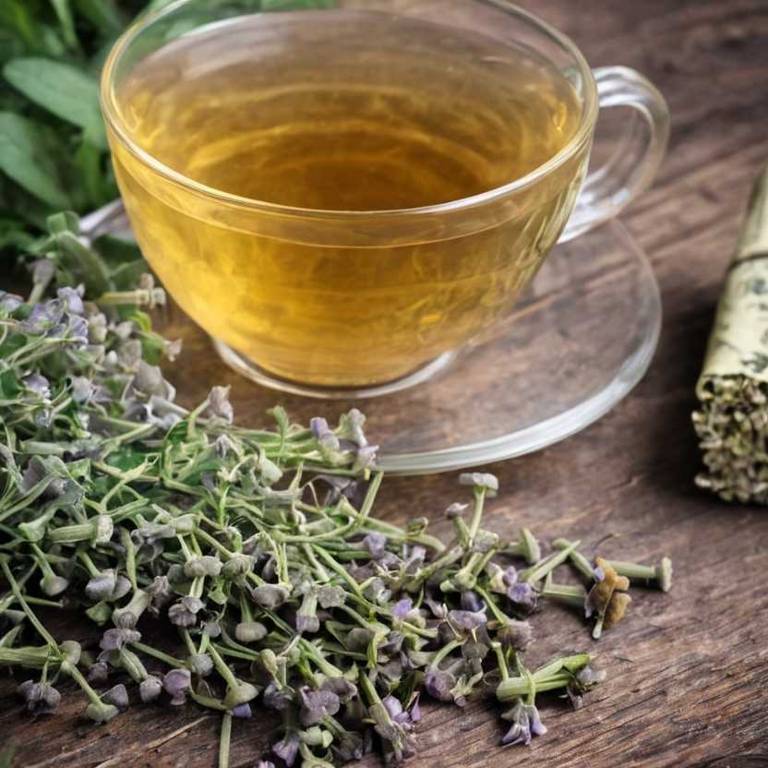
Herbal teas for tendinitis are a natural remedy that helps alleviate pain and inflammation associated with this condition.
They work by reducing inflammation, relaxing muscles, and improving circulation. Examples of herbal teas that help with tendinitis include turmeric, ginger, and arnica. These teas improve lives by reducing pain and discomfort, allowing individuals to engage in physical activities and maintain their daily routines without restriction.
Regular consumption can also promote long-term recovery and overall well-being.
The following article describes in detail the most important teas for tendinitis, including medicinal properties, parts of herbs to use, and recipes for preparations.
- 1. Curcuma longa
- 2. Camellia sinensis
- 3. Echinacea purpurea
- 4. Hypericum perforatum
- 5. Taraxacum officinale
- 6. Aloe vera
- 7. Rosa rugosa
- 8. Cinnamomum verum
- 9. Zingiber officinale
- 10. Melissa officinalis
- What is the best combination of herbal teas to use for tendinitis?
- What ailments similar to tendinitis are treated with herbal teas?
1. Curcuma longa
Curcuma longa, also known as turmeric, teas helps with tendinitis because of its potent anti-inflammatory properties.
The curcumin present in turmeric tea reduces inflammation and pain associated with tendinitis. It also improves joint mobility and reduces oxidative stress. Studies have shown that curcumin can block the production of inflammatory enzymes, leading to faster recovery and reduced symptoms.
Regular consumption of turmeric tea can lead to improved tendon health and reduced risk of further injury, making it a natural and effective remedy for tendinitis sufferers.
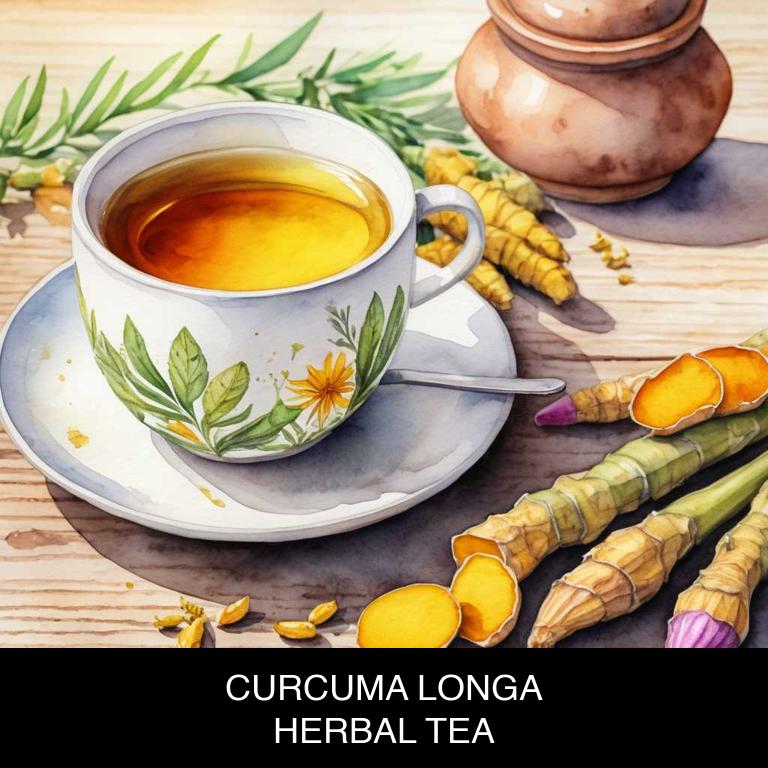
Medicinal Constituents
The list below shows the primary medicinal constituents in Curcuma longa teas that help with tendinitis.
- Curcumin: A polyphenolic compound that helps reduce inflammation and oxidative stress in tendons, thereby alleviating pain and discomfort associated with tendinitis.
- Demethoxycurcumin: A curcuminoid with potent anti-inflammatory and antioxidant properties that inhibit the production of pro-inflammatory enzymes, thereby reducing inflammation and promoting healing in tendons.
- Β-caryophyllene: A sesquiterpene with anti-inflammatory and antioxidant properties that modulate the body's response to inflammation, reducing pain and swelling in tendons affected by tendinitis.
Parts Used
The list below shows the primary parts of turmeric used to make teas for tendinitis.
- Rhyzomes: Turmeric rhyzomes are used to make teas for tendinitis because they contain curcumin, a potent anti-inflammatory compound.
- Roots: Turmeric roots are used to make teas for tendinitis because they are a rich source of curcumin, which helps reduce inflammation and pain.
- Leaves: Turmeric leaves are used to make teas for tendinitis because they contain compounds similar to curcumin, providing anti-inflammatory and antioxidant properties.
Quick Recipe
The following recipe gives a procedure to make a basic turmeric for tendinitis.
- Wash 2-3 teaspoons of dried curcuma longa powder under cold running water for 10 seconds.
- Steep the powder in 1 liter of boiling water for 5-7 minutes to release the active compounds.
- Strain the liquid through a fine-mesh sieve into a teapot or cup to remove the solids.
- Add 1-2 teaspoons of honey or sugar to taste and stir well to dissolve the sweetener.
- Serve the tea immediately and consume within 30 minutes to 1 hour for maximum benefits.
2. Camellia sinensis
Camellia sinensis, also known as tea, teas helps with tendinitis because of its anti-inflammatory and antioxidant properties.
The flavonoids and catechins present in tea have been shown to reduce inflammation and alleviate pain associated with tendinitis. The antioxidant properties of tea also help to protect against oxidative stress, which can contribute to the development of tendinitis. Additionally, tea has been found to improve blood flow and reduce muscle spasms, both of which can help to alleviate symptoms of tendinitis.
This makes tea a natural and effective remedy for those suffering from tendinitis.
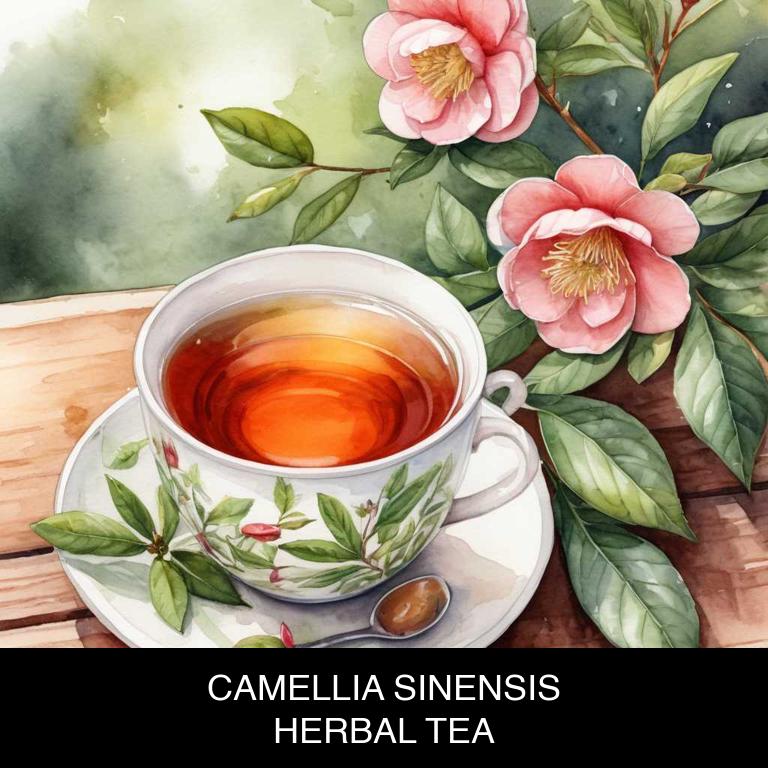
Medicinal Constituents
The list below shows the primary medicinal constituents in Camellia sinensis teas that help with tendinitis.
- Catechins: EGCG has anti-inflammatory properties that can help reduce inflammation and alleviate pain associated with tendinitis.
- Theaflavins: Theaflavins have potent anti-inflammatory and antioxidant effects, which can help reduce oxidative stress and inflammation in tendons, thereby alleviating tendinitis symptoms.
- Quinic acid: Quinic acid has anti-inflammatory properties that can help reduce inflammation and alleviate pain associated with tendinitis by inhibiting the production of pro-inflammatory enzymes.
Parts Used
The list below shows the primary parts of tea used to make teas for tendinitis.
- Leaves: Camellia sinensis leaves are used to make teas due to their anti-inflammatory properties, which can help alleviate tendinitis symptoms.
- Stems: Camellia sinensis stems are used to make teas due to their antioxidant properties, which can help reduce inflammation and promote healing.
- Rhyzomes: Camellia sinensis rhyzomes are used to make teas due to their anti-inflammatory and antioxidant properties, which can help alleviate pain and inflammation associated with tendinitis.
Quick Recipe
The following recipe gives a procedure to make a basic tea for tendinitis.
- Harvest 2-3 high-quality leaves and young shoots from the camellia sinensis plant.
- Cut the leaves and young shoots into small pieces using scissors or a sharp knife.
- Steep 1 teaspoon of camellia sinensis leaves in 8 ounces of boiling water for 3-5 minutes.
- Strain the tea leaves from the liquid using a fine-mesh sieve or cheesecloth immediately.
- Serve the tea hot or iced and enjoy the complex flavors and aromas.
3. Echinacea purpurea
Echinacea purpurea, also known as purple coneflower, teas helps with tendinitis because it contains compounds that have anti-inflammatory properties, which can reduce swelling and pain associated with tendinitis.
The tea's active ingredients, such as alkylamides and caffeic acid, may also help to reduce oxidative stress and promote tissue repair.
Additionally, Echinacea's immunomodulatory effects can aid in reducing inflammation and promoting healing, making it a potentially beneficial herbal remedy for individuals suffering from tendinitis.

Medicinal Constituents
The list below shows the primary medicinal constituents in Echinacea purpurea teas that help with tendinitis.
- Cichoric acid: Helps reduce inflammation and alleviate pain associated with tendinitis by inhibiting the production of pro-inflammatory enzymes.
- Isoquercetin: Acts as an anti-inflammatory agent, reducing swelling and discomfort in tendons by blocking the activity of pro-inflammatory cytokines.
- Caffeic acid: Exhibits antioxidant properties, protecting tendons from oxidative damage and promoting tissue repair, which may aid in the healing of tendinitis.
Parts Used
The list below shows the primary parts of purple coneflower used to make teas for tendinitis.
- Roots: They are used to make teas due to their high concentration of alkaloids and glycosides, which are believed to have anti-inflammatory properties.
- Leaves: Leaves are used in teas as they contain flavonoids and phenolic acids that may help reduce inflammation and alleviate pain associated with tendinitis.
- Flowers: Echinacea flowers are often used in teas for their potential anti-inflammatory and antioxidant properties, which may help alleviate tendinitis symptoms.
Quick Recipe
The following recipe gives a procedure to make a basic purple coneflower for tendinitis.
- Harvest echinacea purpurea roots and flowers at peak maturity for optimal potency and flavor.
- Dry the harvested echinacea purpurea parts in a low-temperature oven at 150 degrees fahrenheit for 2 hours.
- Grind 2 teaspoons of dried echinacea purpurea root into a fine powder using a spice grinder.
- Combine the ground root powder with 1 teaspoon of dried echinacea purpurea flowers in a tea infuser.
- Steep the tea infuser in 8 ounces of boiling water for 5 to 7 minutes to release the herbal properties.
4. Hypericum perforatum
Hypericum perforatum, also known as St. John's Wort, teas helps with tendinitis because of its anti-inflammatory and antioxidant properties.
The tea contains hyperforin and hypericin, compounds that have been shown to reduce inflammation and promote healing in damaged tissues. This makes it an effective remedy for reducing pain and discomfort associated with tendinitis.
The tea's ability to improve blood flow and reduce oxidative stress also contributes to its therapeutic benefits, making it a popular natural treatment for this common condition.
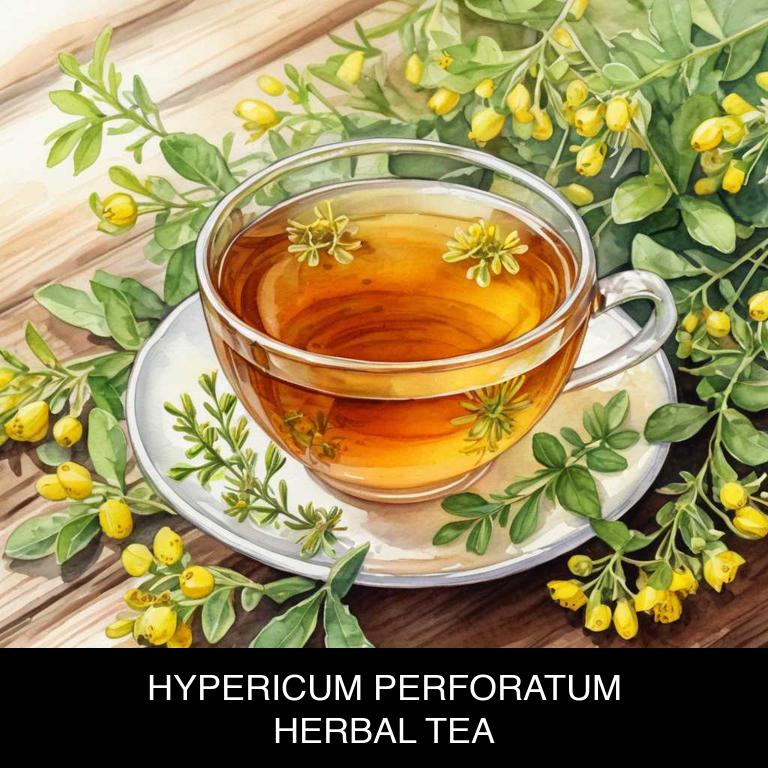
Medicinal Constituents
The list below shows the primary medicinal constituents in Hypericum perforatum teas that help with tendinitis.
- Hyperforin: Acts as a potent anti-inflammatory agent, reducing inflammation and pain associated with tendinitis.
- Quercetin: Exhibits antioxidant properties that help to reduce oxidative stress, alleviate pain, and promote tissue repair in tendinitis.
- Naphthodianthrone: Demonstrates strong anti-inflammatory and antioxidant activities, which contribute to the relief of pain and inflammation in tendinitis.
Parts Used
The list below shows the primary parts of st john's wort used to make teas for tendinitis.
- Leaves: They contain flavonoids and phenolic acids, which are believed to reduce inflammation and pain associated with tendinitis.
- Flowers: They are rich in flavonoids, such as hyperforin and hypericin, which have anti-inflammatory properties that may help alleviate tendinitis symptoms.
- Stems: They contain a combination of flavonoids and other bioactive compounds that may help reduce inflammation and promote healing in tendinitis.
Quick Recipe
The following recipe gives a procedure to make a basic st john's wort for tendinitis.
- Harvest 1 to 2 ounces of dried hypericum perforatum flowers and leaves from a clean environment.
- Crush the dried herbs into a fine powder using a mortar and pestle or coffee grinder.
- Steep 1 teaspoon of the powdered herb in 8 ounces of boiling water for 5 to 10 minutes.
- Strain the liquid through a fine-mesh sieve into a cup and discard the solids.
- Allow the tea to cool to room temperature before consumption within 30 minutes.
5. Taraxacum officinale
Taraxacum officinale, also known as dandelion, teas helps with tendinitis because of its anti-inflammatory and antioxidant properties.
The tea's flavonoids and phenolic acids have been shown to reduce inflammation and pain associated with tendinitis. Additionally, its diuretic properties help in reducing fluid buildup and swelling around the affected area, promoting faster recovery. The tea also contains sesquiterpene lactones, which have been found to have chondroprotective effects, protecting and repairing damaged cartilage.
This makes Taraxacum officinale tea a promising natural remedy for tendinitis relief.
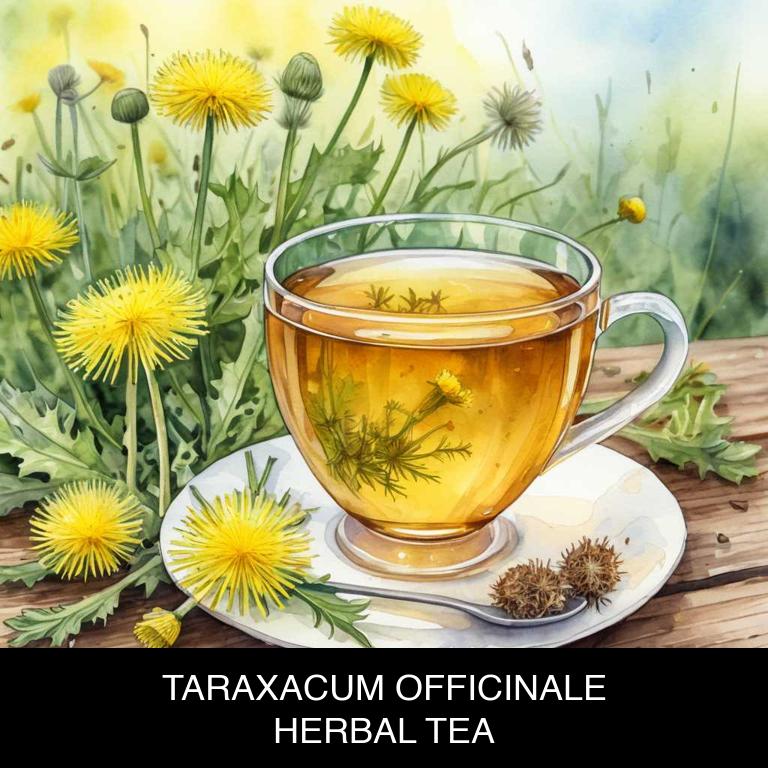
Medicinal Constituents
The list below shows the primary medicinal constituents in Taraxacum officinale teas that help with tendinitis.
- Flavonoids: Flavonoids present in Taraxacum officinale tea have anti-inflammatory properties, which may help reduce pain and inflammation associated with tendinitis.
- Polysaccharides: Polysaccharides in Taraxacum officinale tea may stimulate the immune system and promote the production of anti-inflammatory cytokines, leading to reduced inflammation and healing in tendinitis.
- Saponins: Saponins found in Taraxacum officinale tea have anti-inflammatory and antioxidant properties, which can help reduce oxidative stress and inflammation in tendinitis, promoting healing and reducing pain.
Parts Used
The list below shows the primary parts of dandelion used to make teas for tendinitis.
- Leaves: Used due to their anti-inflammatory properties that help alleviate tendinitis symptoms.
- Flowers: Utilized for their flavonoid content, which contributes to their anti-inflammatory and antioxidant effects.
- Roots: Employed for their potential in reducing inflammation and promoting the healing of tendinous tissues.
Quick Recipe
The following recipe gives a procedure to make a basic dandelion for tendinitis.
- Harvest the dandelion roots and leaves in early spring or fall when the plant is dormant for 30 minutes.
- Clean the harvested dandelion roots and leaves by gently washing them with cold water for 10 minutes.
- Dry the clean dandelion roots and leaves in a single layer on a paper bag for 2 hours.
- Steep one tablespoon of dried dandelion root or two tablespoons of dried dandelion leaves in one cup of boiling water for 5 minutes.
- Strain the dandelion tea through a cheesecloth or a fine-mesh sieve into a cup and serve immediately.
6. Aloe vera
Aloe vera, also known as aloe, teas helps with tendinitis because it contains anti-inflammatory compounds such as aloin and aloe-emodin.
These compounds reduce swelling and pain associated with tendinitis, allowing for improved mobility and flexibility. Aloe vera's anti-inflammatory properties also help to reduce oxidative stress, which can contribute to the development of tendinitis.
Additionally, aloe vera's soothing and calming effects can help to reduce stress and promote overall well-being, making it a popular natural remedy for tendinitis sufferers.
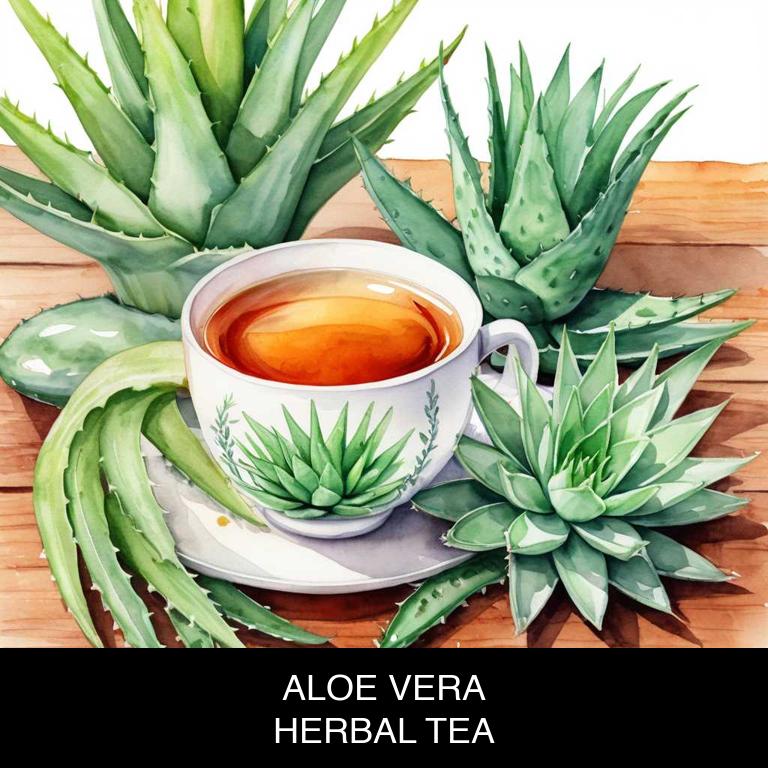
Medicinal Constituents
The list below shows the primary medicinal constituents in Aloe vera teas that help with tendinitis.
- Aloe-emodin: Aloe-emodin, a phenolic compound, helps with tendinitis by reducing inflammation and pain due to its anti-inflammatory properties.
- Aloe vera gel polysaccharides: Aloe vera gel polysaccharides, particularly acemannan, contribute to its anti-inflammatory and immunomodulatory effects, which may help alleviate tendinitis symptoms.
- Furocoumarins: Furocoumarins, a class of furanocoumarin compounds, possess anti-inflammatory and antioxidant properties, which may aid in reducing pain and inflammation associated with tendinitis.
Parts Used
The list below shows the primary parts of aloe used to make teas for tendinitis.
- Leaves: The most commonly used part of Aloe vera, leaves contain a gel-like substance that is rich in anti-inflammatory compounds, which help alleviate tendinitis symptoms.
- Rhyzomes: Rhyzomes of Aloe vera contain a compound called aloin, which has anti-inflammatory properties that aid in reducing pain and inflammation associated with tendinitis.
- Roots: Aloe vera roots contain a compound called aloin, similar to rhyzomes, which helps in reducing inflammation and alleviating pain in tendinitis.
Quick Recipe
The following recipe gives a procedure to make a basic aloe for tendinitis.
- Harvest 100-200 grams of aloe vera leaves with a thick green color from mature plants.
- Peel the leaves carefully to expose the gel inside and discard the outer skin.
- Weigh 20 grams of the aloe vera gel and mix it with 1 liter of boiling water.
- Steep the mixture for 10-15 minutes to allow the aloe vera gel to infuse into the water.
- Strain the tea through a cheesecloth or fine-mesh sieve into a cup to remove solids.
7. Rosa rugosa
Rosa rugosa, also known as beach rose, teas helps with tendinitis because of its anti-inflammatory properties.
The plant contains a high concentration of flavonoids and phenolic acids, which have been shown to reduce inflammation and alleviate pain. The tea's antioxidant properties also help to protect the tendons from further damage, promoting healing and reducing scar tissue formation.
Additionally, Rosa rugosa tea's anti-inflammatory compounds may help to reduce inflammation and promote blood flow to the affected area, leading to faster recovery and reduced discomfort.

Medicinal Constituents
The list below shows the primary medicinal constituents in Rosa rugosa teas that help with tendinitis.
- Flavonoids: These plant compounds have anti-inflammatory properties, which can help alleviate pain and reduce swelling associated with tendinitis.
- Phenolic acids: Phenolic acids, such as gallic acid and ellagic acid, have been shown to possess anti-inflammatory and antioxidant properties, which may help reduce inflammation and promote tissue repair in tendinitis.
- Rosmarinic acid: This polyphenol has been reported to possess anti-inflammatory and antioxidant properties, which can help reduce pain and inflammation associated with tendinitis.
Parts Used
The list below shows the primary parts of beach rose used to make teas for tendinitis.
- Leaves: Rosa rugosa leaves are used to make teas for tendinitis due to their anti-inflammatory properties that help reduce swelling and pain in the affected areas.
- Flowers: Rosa rugosa flowers are used to make teas for tendinitis due to their anti-inflammatory and antioxidant properties that help soothe and calm the affected muscles and joints.
- Roots: Rosa rugosa roots are used to make teas for tendinitis due to their analgesic and anti-inflammatory properties that help reduce pain and inflammation in the affected areas.
Quick Recipe
The following recipe gives a procedure to make a basic beach rose for tendinitis.
- Gather rosa rugosa flowers and leaves in quantities of 1 tablespoon for every 8 ounces of water.
- Steep the rosa rugosa flowers and leaves in boiling water for 5 to 7 minutes.
- Strain the tea through a cheesecloth or fine-mesh sieve to remove solids.
- Add honey to taste if desired to sweeten the tea.
- Serve the tea warm or iced and enjoy within 24 hours of preparation.
8. Cinnamomum verum
Cinnamomum verum, also known as Ceylon cinnamon, teas helps with tendinitis because of its potent anti-inflammatory and antioxidant properties.
The tea's active compounds, such as cinnamaldehyde, work by reducing inflammation and oxidative stress in the affected joints, promoting healing and reducing pain. Additionally, the tea's warming and soothing effects can help relax muscles and improve blood circulation, further aiding in the recovery process and alleviating symptoms associated with tendinitis.
This natural remedy offers a promising alternative for managing tendinitis.
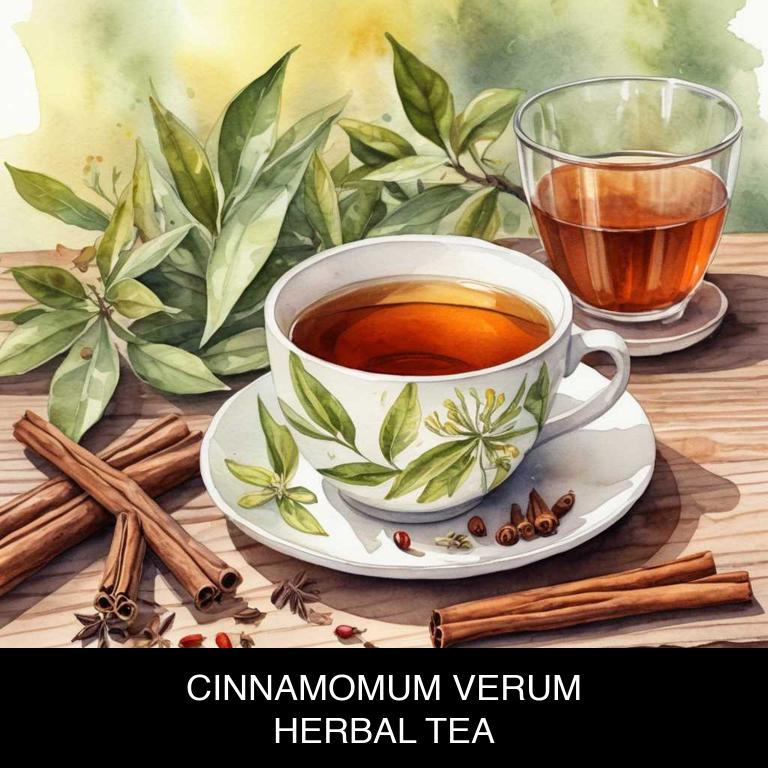
Medicinal Constituents
The list below shows the primary medicinal constituents in Cinnamomum verum teas that help with tendinitis.
- Cinnamaldehyde: This terpene compound has anti-inflammatory properties, which can help reduce inflammation and pain associated with tendinitis.
- Cinnamic acid: This phenolic compound has antioxidant and anti-inflammatory effects, which can help protect against tissue damage and promote healing in tendons.
- Coumarin: This phenolic compound has anti-inflammatory and analgesic properties, which can help reduce pain and inflammation in tendons, promoting faster recovery from tendinitis.
Parts Used
The list below shows the primary parts of ceylon cinnamon used to make teas for tendinitis.
- Leaves: They are used to make teas due to their anti-inflammatory properties, which can help alleviate tendinitis symptoms.
- Rhyzomes: The rhyzomes contain oils that help reduce inflammation and relieve pain associated with tendinitis.
- Barks: Cinnamon bark, in particular, is used in teas due to its anti-inflammatory and analgesic properties, which can help soothe tendinitis pain.
Quick Recipe
The following recipe gives a procedure to make a basic ceylon cinnamon for tendinitis.
- Harvest 2-3 fresh cinnamomum verum bark pieces weighing about 1 ounce for brewing.
- Dry the cinnamomum verum bark pieces in a low-temperature oven at 150 degrees fahrenheit for 2 hours.
- Grind 1/2 teaspoon of dried cinnamomum verum bark into a fine powder using a spice grinder.
- Steep 1 teaspoon of the ground cinnamomum verum in 8 ounces of boiling water for 5-7 minutes.
- Strain and serve the tea immediately after brewing to enjoy the herbal benefits.
9. Zingiber officinale
Zingiber officinale, also known as ginger, teas helps with tendinitis because of its anti-inflammatory properties.
The active compounds in ginger, such as gingerols and shogaols, have been shown to reduce pain and inflammation in the affected joints and tendons. These compounds also have a natural analgesic effect, which can help alleviate pain and discomfort associated with tendinitis. By reducing inflammation and pain, ginger teas can promote healing and provide relief for those suffering from tendinitis.
Regular consumption may also aid in preventing further inflammation.

Medicinal Constituents
The list below shows the primary medicinal constituents in Zingiber officinale teas that help with tendinitis.
- Gingerols: These sesquiterpene compounds have anti-inflammatory properties, which help reduce pain and swelling in tendons, thereby alleviating tendinitis symptoms.
- Shogaols: These bioactive compounds have potent anti-inflammatory and antioxidant effects, which help reduce inflammation and oxidative stress in tendons, ultimately reducing pain and discomfort associated with tendinitis.
- Zingerone: This ginger-derived compound has anti-inflammatory and antioxidant properties, which help reduce inflammation and oxidative stress in tendons, promoting healing and reducing pain associated with tendinitis.
Parts Used
The list below shows the primary parts of ginger used to make teas for tendinitis.
- Roots: The roots of Zingiber officinale are also used to make teas for tendinitis, as they contain bioactive compounds that have anti-inflammatory and analgesic properties.
- Buds: The buds of Zingiber officinale are sometimes used in teas for tendinitis, as they are rich in antioxidants and volatile oils that may help to reduce inflammation and promote healing.
Quick Recipe
The following recipe gives a procedure to make a basic ginger for tendinitis.
- Gather 1-2 teaspoons of fresh zingiber officinale rhizome or 1 teaspoon of dried root material for this herbal tea recipe.
- Wash the rhizome or root material thoroughly with cold water to remove any dirt or impurities.
- Chop the rhizome or root material into small pieces to release its active compounds and flavors.
- Steep 1 teaspoon of the chopped rhizome or root material in 8 ounces of boiling water for 5-7 minutes to create a soothing tea.
- Strain the tea and discard the solids to serve the herbal tea hot or at room temperature.
10. Melissa officinalis
Melissa officinalis, also known as lemon balm, teas helps with tendinitis because it contains rosmarinic acid, a powerful anti-inflammatory compound that reduces swelling and pain in the affected area.
The tea's soothing properties also promote relaxation and reduce muscle tension, allowing for improved blood flow and faster healing. Additionally, lemon balm's antioxidant properties help protect the affected tissues from oxidative stress, further facilitating the recovery process and alleviating tendinitis symptoms.
Regular consumption may help alleviate chronic pain and inflammation associated with tendinitis.

Medicinal Constituents
The list below shows the primary medicinal constituents in Melissa officinalis teas that help with tendinitis.
- Rosmarinic acid: A phenolic compound that has anti-inflammatory and antioxidant properties, which may help reduce pain and inflammation associated with tendinitis.
- Nepetalactone: A monoterpene with analgesic and anti-inflammatory properties, which may help alleviate pain and discomfort caused by tendinitis.
- Borneol: A monoterpene with anti-inflammatory and analgesic properties, which may help reduce inflammation and pain in tendinitis.
Parts Used
The list below shows the primary parts of lemon balm used to make teas for tendinitis.
- Leaves: They are rich in antioxidants and anti-inflammatory compounds, which help to reduce pain and inflammation associated with tendinitis.
- Stems: They contain compounds that help to reduce inflammation and promote healing in the affected area.
- Flowers: They have anti-inflammatory and antioxidant properties, which help to alleviate pain and swelling associated with tendinitis.
Quick Recipe
The following recipe gives a procedure to make a basic lemon balm for tendinitis.
- Gather dried melissa officinalis leaves from a reputable source or harvest your own in the summer months.
- Steep 1-2 teaspoons of dried melissa officinalis leaves in 8 ounces of boiling water for 5-7 minutes.
- Strain the tea through a fine-mesh sieve into a cup to remove loose leaves and particles.
- Add honey or lemon to taste and adjust the sweetness or sourness levels as needed.
- Enjoy your herbal melissa officinalis tea immediately while it is still warm and fragrant.
What is the best combination of herbal teas to use for tendinitis?
The best combination of herbal teas that help with tendinitis is a blend of Willow Bark, Ginger, and Turmeric teas.
Willow Bark contains salicin, a natural anti-inflammatory that reduces pain and swelling. Ginger's anti-inflammatory properties and warming effect help to ease stiffness and discomfort.
Turmeric's curcumin fights inflammation and promotes healing. This trio of teas, when consumed regularly, can provide relief from tendinitis symptoms and promote recovery.
Drinking a cup of this blend after exercise or physical activity can also help prevent flare-ups.
What ailments similar to tendinitis are treated with herbal teas?
Ailments similar to tendinitis/teas.html">tendinitis/teas.html">tendinitis that are treated with herbal teas are conditions such as bursitis, periarthritis, and myofascial pain syndrome.
These conditions often involve inflammation and stiffness in joints or muscles, and herbal teas like ginger, turmeric, and willow bark have anti-inflammatory properties that can help alleviate symptoms.
Other herbs like lavender, chamomile, and peppermint can also provide relief from pain and promote relaxation.